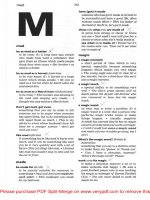Tài liệu Chapter 9: Center of Mass and Linear Momentum docx
Bạn đang xem bản rút gọn của tài liệu. Xem và tải ngay bản đầy đủ của tài liệu tại đây (269.47 KB, 22 trang )
Chapter 9
Center of Mass and Linear Momentum
In this chapter we will introduce the following new concepts:
-Center of mass (com) for a system of particles
-The velocity and acceleration of the center of mass
-Linear momentum for a single particle and a system of particles
We will derive the equation of motion for the center of mass, and
discuss the principle of conservation of linear momentum
Finally we will use the conservation of linear momentum to study
collisions in one and two dimensions and derive the equation of
motion for rockets
(9-1)
1 2
1
1 1 2 2
1 2
2
Consider a system of two particles of masses and
at positions and , respectively. We define the
position of the center of mass (com) as follow
The Center
s:
of Mass:
com
m x m x
x
m m
m m
x x
+
=
+
1 1 2 2 3 3 1 1 2 2 3 3
1
1 2 3
...
We can generalize the above definition for a system of particles as follows:
Here is the total mass of all the pa
...
1
..
rt
.
ic
n
n n n n
com i i
i
n
m x m x m x m x m x m x m x m x
x m x
m m m m
n
M
M M
=
+ + + + + + + +
= = =
+ + + +
∑
1 2 3
les ...
We can further generalize the definition for the center of mass of a system of
particles in three dimensional space. We assume that the the -th particle
( mass ) has posi
n
i
M m m m m
i
m
= + + + +
1
tion vector
1
n
com i i
i
i
r
r
m r
M
=
=
∑
r
r
r
(9-2)
1
1
The position vector for the center of mass is given by the equation:
ˆ
ˆ ˆ
The position vector can be written as:
The components of are given by the
n
com i i
i
com com com com
com
r m r
M
r x i y j z k
r
=
=
= + +
∑
r r
r
r
1 1 1
1 1 1
equations:
n n n
com i i com i i com i i
i i i
x m x y m y z m z
M M M
= = =
= = =
∑ ∑ ∑
The center of mass has been defined using the quations
given above so that it has the following prope
The center of mass of a system of particles moves as though
all the system's mass were conc
rty:
etra
The abolve statement will be proved lat
ted there, and that the
vector sum of a
er. An example is
given in the figure.
ll t
A b
he external forces were
aseball bat is flipped
applied th
into the a
ere
ir
and moves under the influence of the gravitation force. The
center of mass is indicated by the black dot. It follows a
parabolic path as discussed in Chapter 4 (projectile motion)
All the other points of the bat follow more complicated paths
(9-3)
Solid bodies can be considered as systems with continuous distribution of matter
The sums that are used for the calculation of the c
The Center of Mass for Solid Bod
enter of mass of systems with
d
ies
iscrete distribution of mass become integrals:
The integrals above are rather complicated.
1 1 1
A simpler special case is that of
uniform objects in wh
ic
com com com
x xdm y ydm z zdm
M M M
= = =
∫ ∫ ∫
h the mass density is constant and equal to
In objects with symetry elements (symmetry point, symmetry line, symmetry
1 1 1
plane)
it
is not
com com com
x xdV y ydV z zdV
V V
dm M
dV V
V
ρ
= = =
=
∫ ∫ ∫
necessary to eveluate the integrals. The center of mass lies on the symmetry
element. For example the com of a uniform sphere coincides with the sphere center
In a uniform rectanglular object the com lies at the intersection of the diagonals
(9-4)
.
C
C
O
m
1
m
3
m
2
F
1
F
2
F
2
x
y
z
1 2 3,
1 2 3
Consider a system of particles of masses , , ...,
and position vectors , , ,...
Newton's Second Law for
, , respectively.
a System of Particle
The position vector of the center of mas
s
n
n
n m m m m
r r r r
r r r r
s is given by:
1 1 2 2 3 3
1 1 2 2 3 3
1 1 2 2 3 3
... We take the time derivative of both sides
...
... Here is the velocity of the c
com n n
com n n
com n n com
Mr m r m r m r m r
d d d d d
M r m r m r m r m r
dt dt dt dt dt
Mv m v m v m v m v v
= + + + + →
= + + + + →
= + + + +
r r r r r
r r r r r
r r r r r r
1 1 2 2 3 3
1 1 2 2 3 3
om
and is the velocity of the -th particle. We take the time derivative once more
...
... Here is the acceler
i
com n n
com n n com
v i
d d d d d
M v m v m v m v m v
dt dt dt dt dt
Ma m a m a m a m a a
→
= + + + + →
= + + + +
r
r r r r r
r r r r r r
ation of the com
and is the acceleration of the -th particle
i
a i
r
(9-5)
O
m
1
m
3
m
2
F
1
F
2
F
2
x
y
z
1 1 2 2 3 3
1 2 3
...
We apply Newton's second law for the -th particle:
Here is the net force on the -th particle
...
com n n
i i i i
com n
Ma m a m a m a m a
i
m a F F i
Ma F F F F
= + + + +
=
= + + + +
r r r r r
r r
r
r r r r
r
( ) ( ) ( ) ( )
int
int int int int
1 1 2 2 3 3
The force can be decomposed into two components: applied and internal
The above equation takes the form:
...
i
app
i i i
app app app app
com n n
F
F F F
Ma F F F F F F F F
Ma
= +
= + + + + + + + + →
r
r r r
r r r r r r r r
r
r
( ) ( )
int int int int
1 2 3 1 2 3
... ...
The sum in the first parenthesis on the RHS of the equation above is just
The sum in the second parethesis on the RHS van
app app app app
com n n
net
F F F F F F F F
F
= + + + + + + + + +
r r r r r r r r
r
, , , , ,
ishes
by virtue of Newton's third law.
The equation of motion for the center of mass becomes:
In terms of components we have:
com net
net x com x net y com y net z
Ma F
F Ma F Ma F
=
= =
r
r
,
com z
Ma=
(9-6)
com net
Ma F=
r
r
, ,
, ,
, ,
net x com x
net y com y
net z com z
F Ma
F Ma
F Ma
=
=
=
The equations above show that the center of mass of a system of particles
moves as though all the system's mass were concetrated there, and that the
vector sum of all the external forces were applied there. A dramatic example is
given in the figure. In a fireworks display a rocket is launched and moves under
the influence of gravity on a parabolic path (projectile motion). At a certain point
the rocket explodes into fragments. If the explosion had not occured, the rocket
would have continued to move on the parabolic trajectory (dashed line). The forces
of the explosion, even though large, are all internal and as such cancel out. The
only external force is that of gravity and this remains the same before and after the
explosion. This means that the center of mass of the fragments folows the same
parabolic trajectory that the rocket would have followed had it not exploded
(9-7)
m
v
p
Linear momentum of a particle of mass and velocity
The
Linear Momentum
SI unit for li
is defined as
neal momentum
:
is the kg
.m/s
p mv
p m v
=
r
r r
r
p mv=
r r
The time rate of change of the linear
momentum of a particle is equal to the magnitude of net force acting on th
Below we will prove the fol
e
particle and has the direc
lowing statem
tion of the f
ent:
orce
( )
In equation form: We will prove that this equation using
Newton's second law
This equation is stating that the linear momentum of a particle can be c
net
net
dp
F
dt
dp d dv
p mv mv m ma F
dt dt dt
=
= → = = = =
r
r
r r
r
r r r r
hanged
only by an external force. If the net external force is zero, the linear momentum
cannot change
net
dp
F
dt
=
r
r
(9-8)









